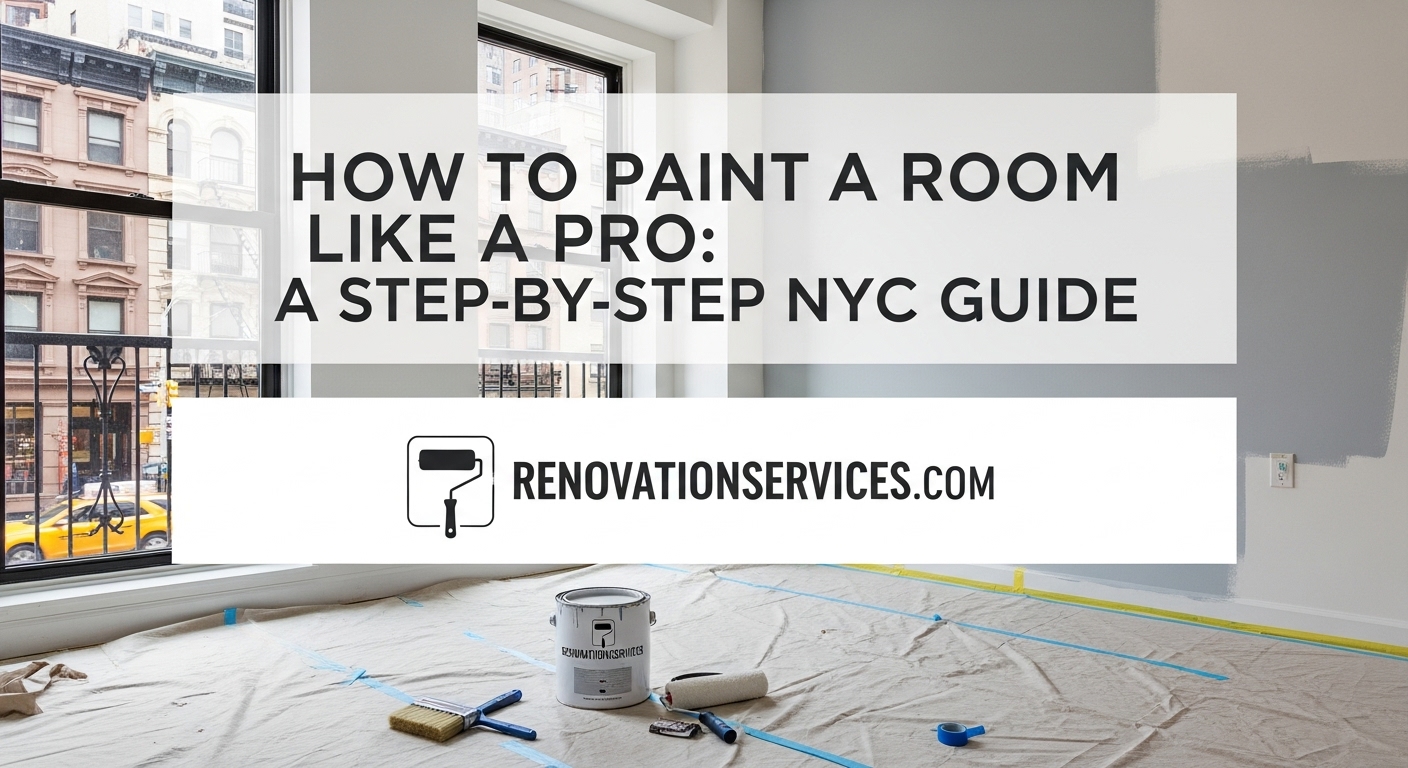How to Paint a Room Like a Professional
Go beyond the basics with our comprehensive guide to achieving a truly flawless, durable, and professional-quality paint job in any room of your home.
Get a Free Professional Painting QuoteLast Updated: September 25, 2025
There are few home improvement projects that offer the transformative power of a fresh coat of paint. It’s a relatively inexpensive way to completely redefine a space, making it feel cleaner, brighter, and more personalized. However, there is a vast difference between a rushed, amateur paint job and a flawless, professional finish. The difference isn’t in some secret, unattainable skill; it’s in the preparation, the technique, and the attention to detail.
Simply rolling a new color onto your walls might seem easy, but it often leads to drips, uneven coverage, roller marks, and peeling tape that ruins your hard work. A professional result—the kind that looks perfectly crisp and lasts for years—comes from following a methodical process. It’s about 80% preparation and 20% actual painting. This guide will walk you through that complete process, from planning and prep to the final brush stroke. Whether you’re tackling a bedroom in your Queens apartment or considering a full renovation with our Manhattan painting services, these are the steps and techniques we use every day to achieve perfection. For a detailed breakdown of what to expect, check out our NYC interior painting cost guide.
Key Takeaways from This Guide
- Preparation is 80% of the Job: Proper cleaning, patching, and taping are non-negotiable for a professional finish.
- Choose the Right Tools & Materials: High-quality brushes, rollers, and paint make a significant difference in application and durability.
- Follow a Professional Order: Always paint ceiling, then walls, then trim to manage drips and ensure clean lines.
- Master the “Wet Edge”: The technique of rolling into freshly brushed paint is crucial for avoiding visible lap marks.
- Understand Curing vs. Drying: Paint may be dry to the touch in hours, but it takes weeks to fully cure and harden. Be gentle with your new walls.
Section 1: The Foundation of a Flawless Finish: Planning & Preparation
This is the most critical stage. Rushing your prep work is the single biggest mistake you can make. Proper preparation ensures the paint adheres correctly, looks uniform, and creates crisp, clean lines. It’s the tedious work that makes the final result look effortless. A professional job begins long before a can of paint is opened.
Mastering Color & Sheen Selection
The choice of color and finish will dramatically impact the feel of your room. It goes beyond simply picking a color you like; you must consider the room’s lighting, size, and intended mood.
Understanding Undertones and Light: Natural light changes throughout the day. A north-facing room receives cool, bluish light, which can make warm colors look dull. A south-facing room gets bright, warm light that can intensify colors. Test large paint swatches on different walls and observe them at various times of day. Artificial lighting also plays a role; incandescent bulbs cast a warm, yellow light, while LEDs can be cool or warm. The right color choice harmonizes with these conditions.
Interactive Tool: Room Ambiance Color Selector
Color has a powerful psychological effect. Select the mood you want to create in your room for professional color family suggestions.
Choosing the Right Sheen: The paint aisle can be overwhelming. Let’s simplify it. For interior walls, you’ll almost always use a latex (water-based) paint, many of which are now available in low-VOC or zero-VOC formulas that are better for your indoor air quality, a topic the EPA explains in detail. The key decision is the sheen, or the level of gloss. If you’re struggling with color, our color consultation services can help.
- Flat/Matte: Has no shine. It’s excellent at hiding imperfections on older walls (common in NYC apartments) but is the least durable and hardest to clean. Best for low-traffic areas like ceilings, adult bedrooms, and formal dining rooms.
- Eggshell/Satin: Has a low, subtle sheen that’s elegant and highly popular. It’s more durable and washable than matte, making it a great all-around choice for living rooms, hallways, and bedrooms. Satin is slightly glossier and more durable than eggshell.
- Semi-Gloss: Noticeably shiny and very durable. It’s moisture-resistant and easy to clean, making it the standard choice for trim, doors, bathrooms, and kitchens where wiping down surfaces is common. Its shine will highlight any wall imperfections.
- Gloss: Highly reflective and extremely durable. It’s rarely used for walls but can provide a dramatic, lacquer-like finish on furniture, trim, or architectural details.
Interactive Tool: Which Paint Sheen Do I Need?
Select the room you’re painting to get a professional recommendation.
Calculating How Much Paint You Need
Buying too little paint is frustrating, and too much is wasteful. A general rule is that one gallon of paint covers about 350-400 square feet with one coat. To be more precise, you calculate the area of your walls and subtract the area of windows and doors. Remember to account for two coats for a rich, even color.
Interactive Tool: Paint Gallon Calculator
Enter your room’s dimensions to estimate how much paint you’ll need for two coats.
Preparing the Room: The Pro Checklist
Now, the real work begins. Follow these steps methodically.
- Empty the Room: Remove all furniture. For large items that can’t be moved, push them to the center of the room and cover them completely with plastic sheeting.
- Cover the Floors: Use canvas drop cloths for the floor. They are more durable, less slippery than plastic, and absorb drips. Plastic is fine for covering furniture.
- Remove Hardware: Unscrew and remove all switch plates, outlet covers, light fixtures, and window hardware. Taping around them is messy and looks unprofessional. Keep screws in labeled plastic bags.
- Clean the Walls: This is a crucial, often-skipped step. Walls collect dust, grease (in kitchens), and grime. Wash them with a sponge and a solution of TSP (trisodium phosphate) substitute or simple soap and water. Pay special attention to kitchens (grease) and bathrooms (mildew and soap scum). Let them dry completely. Paint won’t adhere properly to a dirty surface. If your building was constructed before 1978, it’s critical to follow lead-safe practices, as outlined in the EPA’s guide to lead safety.
- Inspect and Patch: Carefully examine the walls for any imperfections. Use a putty knife and spackling compound to fill nail holes, dents, and small cracks. Many older NYC apartments have plaster walls, which may require specialized plaster repair techniques. For larger damage, you may need to follow our guide to repairing drywall. After the spackle is dry, lightly sand it smooth with 220-grit sandpaper until it’s flush with the wall. Wipe away the dust with a damp cloth.
- Caulk Gaps: Use a high-quality, paintable caulk to fill any gaps between the walls and trim, baseboards, or window frames. This creates a seamless, professional look and prevents drafts.
- Tape with Precision: Using high-quality blue painter’s tape (like FrogTape or 3M Blue), carefully tape off the edges of trim, windows, and the ceiling line. Press the edge of the tape down firmly with a putty knife or credit card to create a tight seal. This prevents paint from bleeding underneath. If you’re dealing with old wallpaper, professional wallpaper removal is recommended before any patching or painting.
Section 2: Assembling Your Professional Painting Toolkit
Using high-quality tools is non-negotiable for a high-quality finish. Cheap brushes leave bristles in your paint, and cheap rollers create an uneven texture. Invest in good tools, and they will last for many projects if cleaned properly. Think of these as an investment in a better result.
Brushes
You need one high-quality brush for “cutting in” (painting the edges). A 2.5-inch angled sash brush is the perfect all-purpose tool. The angle gives you precise control along trim and corners. The bristles should be densely packed and tapered to a fine point. Use synthetic bristles (nylon/polyester) for latex paints and natural bristles for oil-based paints.
Rollers & Covers
A standard 9-inch roller frame with a comfortable grip is your workhorse. The key is the roller cover (the fuzzy part). The thickness of the cover’s “nap” depends on your wall texture:
- 1/4″ to 3/8″ nap: For smooth surfaces like new drywall, metal doors, or trim.
- 1/2″ nap: The most common choice for typical interior walls with a light texture.
- 3/4″ nap or thicker: For rough surfaces like textured plaster, stucco, or brick.
The 5-in-1 Tool
This is the painter’s multi-tool and is indispensable. It can be used to open paint cans, clean roller covers, scrape away loose paint, gouge out cracks for patching, and set nails. It’s an inexpensive tool that will save you time and frustration.
Safety Gear
Don’t neglect safety. A dust mask is essential when sanding to avoid inhaling fine particles. Safety glasses will protect your eyes from splatters, especially when painting a ceiling. Good ventilation is also key, so open windows if possible.
Interactive Tool: The Essential Painting Checklist
Here’s everything you’ll need for a professional job. Click to check them off as you gather your supplies.
- High-quality latex paint (and primer, if needed)
- 2.5-inch angled sash brush
- 9-inch roller frame and roller covers (1/2″ nap is standard)
- Paint tray and plastic liners for easy cleanup
- Canvas drop cloths
- High-quality painter’s tape (e.g., FrogTape)
- Spackling compound & Paintable Caulk
- Putty knife (2-inch or 4-inch)
- Fine-grit sandpaper (220-grit)
- Rags or cleaning cloths
- TSP substitute or soap for wall washing
- 5-in-1 painter’s tool (highly recommended)
- Dust mask and safety glasses
- Sturdy step ladder
- Roller extension pole
Section 3: The Professional Painting Process, Step-by-Step
With the prep work done, it’s time to paint. The correct order is crucial: 1. Ceiling, 2. Walls, 3. Trim. This ensures that any drips or splatters from the ceiling and walls won’t ruin a freshly painted surface below.
Step 1: Prime (If Necessary)
Primer creates a uniform base for your paint, ensuring the color looks even and adheres properly. It’s essential in several situations:
Interactive Tool: Primer Decision Tool
Answer these questions to determine if you need to prime, and which type of primer is best for your project.
Step 2: Paint the Ceiling
Always start with the ceiling. Use a flat white ceiling paint, which excels at hiding imperfections. Cut in the edges of the ceiling where it meets the walls. Then, using an extension pole on your roller, paint the main area. Work in 5×5 foot sections, rolling in one direction and then immediately rolling perpendicular to that to ensure even coverage without lap marks.
Step 3: Cut In and Roll the Walls
“Cutting in” is the technique of using a brush to paint areas the roller can’t reach. This means painting a 2-3 inch band along the ceiling line, around trim, in corners, and around fixtures. This is where your angled brush and a steady hand are key. The goal is to create a seamless finish where the brushed areas blend perfectly with the rolled areas.

- Pour about an inch of paint into a small paint pail or cup. Don’t dip your brush directly into the gallon can to avoid contamination.
- Dip only the first third of your brush bristles into the paint. Tap it lightly against the side of the pail; don’t wipe it clean, as you want the brush loaded with paint.
- Holding the brush like a pencil, use the angled edge to apply a smooth, steady line of paint. Work in 3-4 foot sections at a time. The goal is to get a clean line against your tape, but more importantly, to create a painted band wide enough for your roller to meet without bumping the adjacent surface.
- Maintain a Wet Edge: Only cut in one wall at a time. You want to immediately follow with the roller while the brushed paint is still wet. This is called “maintaining a wet edge” and is the single most important technique for avoiding visible lines between the brushed and rolled areas.
- Roll the Walls: Dampen your roller cover slightly with a wet rag. Load your roller evenly with paint from the tray. Start painting a few inches away from the corner. Roll up and down in a large “W” or “N” pattern, about 3 feet wide, to apply the paint. Then, without lifting the roller, go back over the “W” pattern with straight, parallel, floor-to-ceiling strokes to even out the coverage. The final stroke should always be in the same direction (e.g., top to bottom) for a consistent finish. Overlap the wet edge of your previously rolled section by a few inches to ensure a seamless blend. Repeat until the wall is complete.

Step 4: Paint the Trim
Once the walls have had at least 24 hours to dry, you can tape them off to paint the trim (baseboards, window and door frames). Use a semi-gloss paint for durability. Apply two thin coats with your angled sash brush, using long, smooth strokes. Don’t overload the brush to avoid drips.
Interactive Tool: Trim Painting Technique Visualizer
Select the type of trim you’re painting to see the recommended professional technique for clean lines and a smooth finish.
Step 5: Apply the Second Coat
A second coat is almost always necessary for a rich, uniform color and maximum durability. Wait the recommended time between coats, as listed on the paint can (usually 2-4 hours). Applying a second coat too early can re-wet the first coat and cause it to peel up. Repeat the exact same process: cut in one wall, then roll it, maintaining a wet edge.
Section 4: The Final Touches: Cleanup, Curing & Troubleshooting
The job isn’t done until everything is clean and the paint is cured. Proper cleanup protects your tools, and understanding curing time protects your beautiful new walls.
Removing Painter’s Tape
This is a moment of truth. Remove the tape while the second coat of paint is still slightly wet, but not immediately after application (wait about an hour). Pull it off slowly at a 45-degree angle away from the new paint. If you wait until the paint is fully dry, it can form a film over the tape, and you risk peeling off sections of your new paint along with it. If this happens, you’ll need to score the edge of the tape with a utility knife before pulling.
Cleaning Your Tools
For latex paint, cleanup is easy with soap and water. Scrape as much excess paint as possible from brushes and rollers back into the can using a 5-in-1 tool. Wash them thoroughly with warm water and a bit of dish soap until the water runs clear. Use a brush comb to straighten the bristles. Allow them to dry completely before storing.
Interactive Tool: NYC Paint Disposal & Recycling Guide
Properly disposing of paint is essential for protecting the environment. Select your borough for specific guidance from the NYC Department of Sanitation (DSNY).
Dry Time vs. Cure Time
This is a critical distinction.
- Dry Time: The paint will be dry to the touch in a few hours. This is when you can apply a second coat.
- Cure Time: This is the time it takes for the paint to fully harden and become durable. Curing can take anywhere from 7 to 30 days, depending on the paint, temperature, and humidity. During this period, the paint is still soft and susceptible to scratches, scuffs, and damage. Be gentle with the walls. Avoid wiping or scrubbing them, and carefully replace furniture and wall hangings. You can see examples of our finished, fully cured projects in our project gallery.
Interactive Tool: Troubleshooting Common Paint Problems
Even with careful work, issues can arise. Select the problem you’re experiencing to diagnose the cause and find the solution.
Likely Cause: Poor adhesion due to moisture, dirt, or grease on the wall before painting, or painting over an incompatible surface (like oil-based paint).
Solution: Scrape and sand off all the peeling paint. Clean the area thoroughly. If moisture is the issue, address the source. Prime the bare spot with the appropriate primer (e.g., bonding or stain-blocking). Repaint the area, feathering the edges.
About the Author
This guide is brought to you by the team at Renovation Services. With over 15 years of experience providing high-end interior painting services across all five boroughs of New York City, our professional crews have mastered the art of achieving a flawless finish in every type of home, from pre-war apartments to modern condos. We believe in empowering homeowners with the knowledge to tackle their own projects, but we’re always here when you need a professional touch.
Section 5: Your Top 15 Painting Questions Answered
1. What’s the best order to paint a room?
2. How long should I really wait between coats?
3. Is expensive paint actually worth the money?
4. How do I avoid leaving roller marks on the wall?
5. Can I paint latex over oil-based paint?
6. Why is my painter’s tape peeling off the new paint?
7. How do I get a perfectly straight line without tape?
8. What’s the best way to paint behind a toilet?
9. Do I really need to wash the walls first?
10. How do I store leftover paint?
11. What is “boxing” paint and why should I do it?
12. My wall has a slight texture. What roller nap should I use?
13. Should I use a “paint and primer in one” product?
14. How can I fix a drip that has already dried?
15. The previous owners smoked. How do I get rid of the smell and stains?
Ready for a Perfect Paint Job?
Following these steps will give you a beautiful, long-lasting result. But if the process seems overwhelming, or you simply want a guaranteed flawless finish without the hassle, our expert teams are here to help. Contact our painters in Manhattan, Brooklyn, or Queens for a free, no-obligation estimate.






